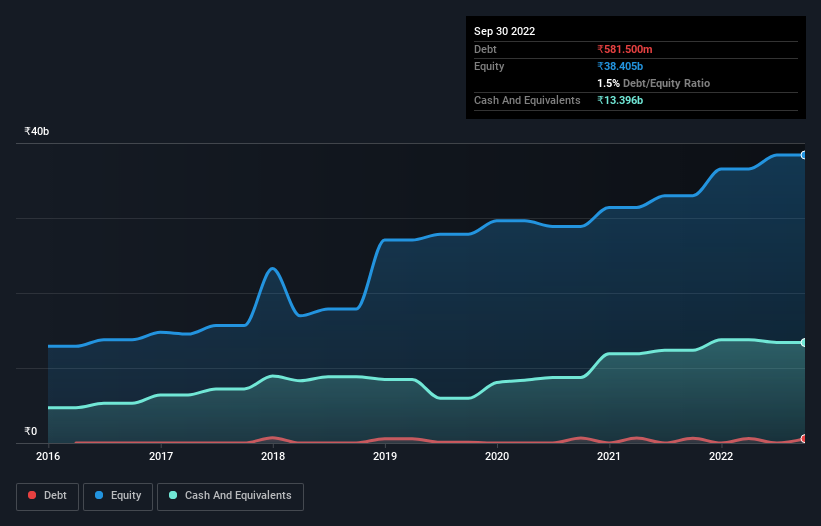Is Schaeffler India (NSE:SCHAEFFLER) A Risky Investment?

The external fund manager backed by Berkshire Hathaway's Charlie Munger, Li Lu, makes no bones about it when he says 'The biggest investment risk is not the volatility of prices, but whether you will suffer a permanent loss of capital.' So it might be obvious that you need to consider debt, when you think about how risky any given stock is, because too much debt can sink a company. As with many other companies Schaeffler India Limited (NSE:SCHAEFFLER) makes use of debt. But is this debt a concern to shareholders?
When Is Debt Dangerous?
Generally speaking, debt only becomes a real problem when a company can't easily pay it off, either by raising capital or with its own cash flow. Ultimately, if the company can't fulfill its legal obligations to repay debt, shareholders could walk away with nothing. However, a more usual (but still expensive) situation is where a company must dilute shareholders at a cheap share price simply to get debt under control. Of course, debt can be an important tool in businesses, particularly capital heavy businesses. When we think about a company's use of debt, we first look at cash and debt together.
See our latest analysis for Schaeffler India
What Is Schaeffler India's Debt?
You can click the graphic below for the historical numbers, but it shows that Schaeffler India had ₹581.5m of debt in June 2022, down from ₹636.7m, one year before. However, its balance sheet shows it holds ₹13.4b in cash, so it actually has ₹12.8b net cash.

How Strong Is Schaeffler India's Balance Sheet?
The latest balance sheet data shows that Schaeffler India had liabilities of ₹14.0b due within a year, and liabilities of ₹518.4m falling due after that. Offsetting these obligations, it had cash of ₹13.4b as well as receivables valued at ₹11.4b due within 12 months. So it can boast ₹10.3b more liquid assets than total liabilities.
This surplus suggests that Schaeffler India has a conservative balance sheet, and could probably eliminate its debt without much difficulty. Succinctly put, Schaeffler India boasts net cash, so it's fair to say it does not have a heavy debt load!
On top of that, Schaeffler India grew its EBIT by 45% over the last twelve months, and that growth will make it easier to handle its debt. When analysing debt levels, the balance sheet is the obvious place to start. But it is Schaeffler India's earnings that will influence how the balance sheet holds up in the future. So when considering debt, it's definitely worth looking at the earnings trend. Click here for an interactive snapshot.
Finally, while the tax-man may adore accounting profits, lenders only accept cold hard cash. While Schaeffler India has net cash on its balance sheet, it's still worth taking a look at its ability to convert earnings before interest and tax (EBIT) to free cash flow, to help us understand how quickly it is building (or eroding) that cash balance. Looking at the most recent three years, Schaeffler India recorded free cash flow of 49% of its EBIT, which is weaker than we'd expect. That's not great, when it comes to paying down debt.
Summing Up
While we empathize with investors who find debt concerning, you should keep in mind that Schaeffler India has net cash of ₹12.8b, as well as more liquid assets than liabilities. And it impressed us with its EBIT growth of 45% over the last year. So is Schaeffler India's debt a risk? It doesn't seem so to us. Over time, share prices tend to follow earnings per share, so if you're interested in Schaeffler India, you may well want to click here to check an interactive graph of its earnings per share history.
If you're interested in investing in businesses that can grow profits without the burden of debt, then check out this free list of growing businesses that have net cash on the balance sheet.
If you're looking to trade Schaeffler India, open an account with the lowest-cost platform trusted by professionals, Interactive Brokers.
With clients in over 200 countries and territories, and access to 160 markets, IBKR lets you trade stocks, options, futures, forex, bonds and funds from a single integrated account.
Enjoy no hidden fees, no account minimums, and FX conversion rates as low as 0.03%, far better than what most brokers offer.
Sponsored ContentNew: Manage All Your Stock Portfolios in One Place
We've created the ultimate portfolio companion for stock investors, and it's free.
• Connect an unlimited number of Portfolios and see your total in one currency
• Be alerted to new Warning Signs or Risks via email or mobile
• Track the Fair Value of your stocks
Have feedback on this article? Concerned about the content? Get in touch with us directly. Alternatively, email editorial-team (at) simplywallst.com.
This article by Simply Wall St is general in nature. We provide commentary based on historical data and analyst forecasts only using an unbiased methodology and our articles are not intended to be financial advice. It does not constitute a recommendation to buy or sell any stock, and does not take account of your objectives, or your financial situation. We aim to bring you long-term focused analysis driven by fundamental data. Note that our analysis may not factor in the latest price-sensitive company announcements or qualitative material. Simply Wall St has no position in any stocks mentioned.
About NSEI:SCHAEFFLER
Schaeffler India
Engages in the development, manufacture, and distribution of high-precision roller and ball bearings, and related components worldwide.
Excellent balance sheet average dividend payer.
Similar Companies
Market Insights
Community Narratives




